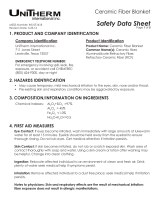Page is loading ...

Page 1 of 2
Alkaline Batteries
June 2007
©2007 Energizer
As a courtesy to our customers, Energizer has prepared copyrighted Product Safety Datasheets to provide information on the different
Eveready/Energizer battery systems. As defined in OSHA Hazard Communication Standard, Section 1910.1200 (c), Eveready/Energizer batteries are
manufactured “articles”, which do not result in exposure to a hazardous chemical under normal conditions of use. For this reason, Material Safety
Datasheets are not required. The information and recommendations set forth herein are made in good faith, for information only, and are believed to be
accurate as of the date of preparation. However, ENERGIZER BATTERY MANUFACTURING, INC., MAKES NO WARRANTY, EITHER EXPRESS OR
IMPLIED, WITH RESPECT TO THIS INFORMATION AND DISCLAIMS ALL LIABILITY FROM REFERENCE ON IT.
PRODUCT SAFETY DATA SHEET
PRODUCT NAME: EVEREADY Battery Type No.: Volts:
TRADE NAMES: ENERGIZER, ENERGIZER e², INDUSTRIAL ZMA, HERCULES,
EVEREADY, WONDER
Approximate Weight:
CHEMICAL SYSTEM: Alkaline Manganese Dioxide-Zinc
Designed for Recharge: No
SECTION I - MANUFACTURER INFORMATION
Energizer Battery Manufacturing, Inc. Telephone Number for Information:
1359 Columbia Rd.
Westlake, OH 44145
800-383-7323 (USA / CANADA)
Date Prepared: June 2007
SECTION II - HAZARDOUS INGREDIENTS
IMPORTANT NOTE: The battery should not be opened or burned. Exposure to the ingredients contained within or their combustion products could be
harmful.
MATERIAL OR INGREDIENT PEL (OSHA) TLV (ACGIH) %/wt.
Graphite
(CAS# 7782-42-5)
15 mg/m
3
TWA (total dust)
5 mg/m
3
TWA (respirable
fraction)
2 mg/m
3
TWA (respirable
fraction)
2-6
Manganese Dioxide
(CAS# 1313-13-9)
5 mg/m
3
Ceiling (as Mn) 0.2 mg/m
3
TWA (as Mn) 30-45
Potassium Hydroxide
(CAS# 1310-58-3)
None established 2 mg/m
3
Ceiling 4-8
Zinc
(CAS# 7440-66-6)
15 mg/m
3
TWA PNOR*
(total dust)
5 mg/m
3
TWA PNOR*
(respirable fraction)
10 mg/m
3
TWA PNOC**
(inhalable particulate)
3 mg/m
3
TWA PNOC**
(respirable paeticulate)
12-25
* PNOR: Particulates not otherwise regulated
**PNOC: Particulates not otherwise classified
SECTION III - FIRE AND EXPLOSION HAZARD DATA
In case of fire, it is permissible to use any class of extinguishing medium on these batteries or their packing material. Cool exterior of batteries if
exposed to fire to prevent rupture.
Fire fighters should wear self-contained breathing apparatus.
SECTION IV - HEALTH HAZARD DATA
Under normal conditions of use, the battery is hermetically sealed.
Ingestion: Swallowing a battery can be harmful.
Contents of an open battery can cause serious chemical burns of mouth, esophagus, and gastrointestinal tract.
If battery or open battery is ingested, do not induce vomiting or give food or drink. Seek medical attention immediately. CALL
NATIONAL BATTERY INGESTION HOTLINE for advice and follow-up (202-625-3333) collect day or night.

Page 2 of 2
Alkaline Batteries
June 2007
©2007 Energizer
Inhalation: Contents of an open battery can cause respiratory irritation. Provide fresh air and seek medical attention.
Skin Contact: Contents of an open battery can cause skin irritation and/or chemical burns. Remove contaminated clothing and
wash skin with soap and water. If a chemical burn occurs or if irritation persists, seek medical attention.
Eye Contact: Contents of an open battery can cause severe irritation and chemical burns. Immediately flush eyes thoroughly with
water for at least 15 minutes, lifting upper and lower lids, until no evidence of the chemical remains. Seek medical attention.
SECTION V - PRECAUTIONS FOR SAFE HANDLING AND USE
Storage: Store in a cool, well ventilated area. Elevated temperatures can result in shortened battery life.
Mechanical Containment: If potting or sealing the battery in an airtight or watertight container is required, consult your
Energizer Battery Manufacturing, Inc. representative for precautionary suggestions. Batteries normally evolve hydrogen which,
when combined with oxygen from the air, can produce a combustible or explosive mixture unless vented. If such a mixture is
present, short circuits, high temperature, or static sparks can cause an ignition.
Do not obstruct safety release vents on batteries. Encapsulation (potting) of batteries will not allow cell venting and can cause high
pressure rupture.
Handling: Accidental short circuit for a few seconds will not seriously affect the battery. Prolonged short circuit will cause the
battery to lose energy, and can cause the safety release vent to open. Sources of short circuits include jumbled batteries in bulk
containers, metal jewelry, metal covered tables or metal belts used for assembly of batteries into devices.
If soldering or welding to the battery is required, consult your Energizer Battery Manufacturing, Inc. representative for proper
precautions to prevent seal damage or short circuit.
Charging: This battery is manufactured in a charged state. It is not designed for recharging. Recharging can cause battery leakage
or, in some cases, high pressure rupture. Inadvertent charging can occur if a battery is installed backwards.
Labeling: If the Eveready label or package warnings are not visible, it is important to provide a package and/or device label
stating:
WARNING: do not install backwards, charge, put in fire, or mix with other battery types. May explode or leak causing
injury. Replace all batteries at the same time.
Where accidental ingestion of small batteries is possible, the label should include:
Keep away from small children. If swallowed, promptly see doctor; have doctor phone (202) 625-3333 collect.
Disposal: Dispose in accordance with all applicable federal, state and local regulations. Appropriate disposal technologies include
incineration and land filling.
SECTION VI - SPECIAL PROTECTION INFORMATION
Ventilation Requirements: Not necessary under normal conditions.
Respiratory Protection: Not necessary under normal conditions.
Eye Protection: Not necessary under normal conditions. Wear safety glasses with side shields if handling an open or leaking
battery.
Gloves: Not necessary under normal conditions. Use neoprene or natural rubber gloves if handling an open or leaking battery.
SECTION VII - REGULATORY INFORMATION
Batteries marketed by Energizer Battery Manufacturing, Inc. have been classified as non-dangerous goods by the US Department of Transportation and
the major international regulatory bodies and are therefore not regulated.
SARA/TITLE III - As an article, this battery and its contents are not subject to the requirements of the Emergency Planning and Community Right-To-
Know Act.
/

